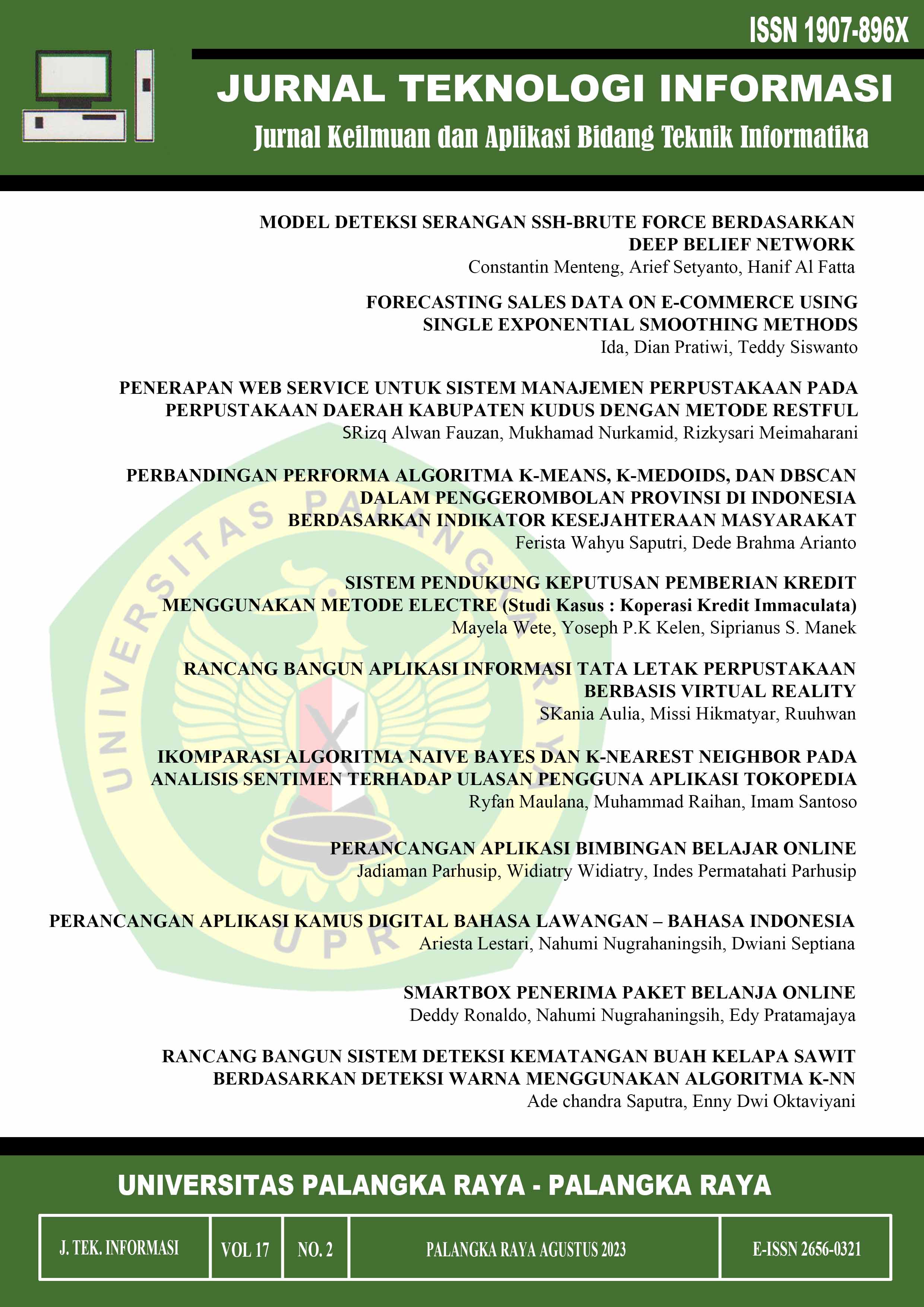PERBANDINGAN PERFORMA ALGORITMA K-MEANS, K-MEDOIDS, DAN DBSCAN DALAM PENGGEROMBOLAN PROVINSI DI INDONESIA BERDASARKAN INDIKATOR KESEJAHTERAAN MASYARAKAT
DOI:
https://doi.org/10.47111/jti.v7i2.9558Keywords:
DBSCAN, K-Means, K-Medoids, Public welfare, t-SNEAbstract
One of the development orientations in Indonesia is to improve the welfare of society. Therefore, it is important to identify and understand the characteristics of community welfare in each province in order to determine effective and targeted development strategies. Cluster analysis is one of the analyses that can be used to group provinces in Indonesia that have homogeneous characteristics within a cluster. The partition method is the simplest and fundamental approach to cluster analysis, but it can only find clusters with spherical-shaped forms. On the other hand, DBSCAN is a density-based clustering algorithm that can be used to find clusters with arbitrary shapes. In this study, the performance of the K-Means, K-Medoids, and DBSCAN algorithms was compared using data that had been dimensionally reduced using the t-SNE method. The data used was the indicator data of community welfare in the year 2022. The evaluation results of clustering based on the highest Silhouette coefficient (0.917) and the lowest Davies-Bouldin index (0.089) indicate that the best clustering methods are K-Means and DBSCAN with parameters perplexity = 1, minPts = 2, and epsilon = 9. Both methods produce the same result, which is the formation of eight clusters.
Downloads
References
BPS. (2022). Jumlah penduduk pertengahan tahun (ribu jiwa) 2020-2022. Available: https://www.bps.go.id/indicator/12/1975/1/jumlah-penduduk-pertengahan-tahun.html.
Budiati I., et al., Indikator Kesejahteraan Rakyat. Jakarta: BPS, 2022.
Dini S.K. and Fauzan A., “Clustering Provinces in Indonesia based on Community Welfare Indicators”, EKSAKTA: Journal of Sciences and Data Analysis, Yogyakarta, vol.1, pp.56-63, Feb. 2020. DOI: 10.20885/EKSAKTA.vol1.iss1.art9
Ditjen Bina Pembangunan Daerah Kementerian dalam Negeri. (2022). Monitoring pelaksanaan 8 aksi Konvergensi Intervensi Penurunan Stunting Terintegrasi. Available: https://aksi.bangda.kemendagri.go.id/emonev/DashPrev/index/4.
Everitt B.S., et al., Cluster Analysis, 5th ed., London: Wiley, 2011.
Hair J.F., et al., Multivariate Data Analysis, 7th ed., New Jersey: Pearson, 2010.
Han J., Kamber M., and Pei J., Data Mining Concepts and Techniques, 3th ed., Waltham: Morgan Kaufmann, 2012.
Hennig Christian, et al., Handbook of cluster analysis. New York: CRC Press, 2015.
Larose D.T. and Larose C.D., Discovering Knowledge in Data An Introduction to Data Mining. London: John Wiley & Sons, 2014.
Otterbach, Johannes. (2016, May.23). Curse of dimensionality, t-SNE and Kullback-Leibler Divergence [online]. Available: https://jotterbach.github.io/content/posts/tsne/2016-05-23-TSNE/.
Ramdhani F., Hoyyi A., and Mukid M.A., “Pengelompokkan provinsi di Indonesia berdasarkan karakteristik kesejahteraan rakyat menggunakan metode K-Means cluster”, Jurnal Gaussian, vol.4, pp.875-884, Oct. 2015.
Riyanto B. “Penerapan algoritma K-Medoids clustering untuk pengelompokkan penyebaran diare di Kota Medan (Studi kasus: Kantor Dinas Kesehatan Kota Medan)”, KOMIK (Konferensi Nasional Teknologi Informasi dan Komputer), vol.3, pp.562–568, Oct. 2019. DOI: 10.30865/komik.v3i1.1659.
Sehgal N.K. and Gupta P., Introduction to Machine Learning in the Cloud with Python: Concepts and Practices. Germany: Springer International Publishing, 2021.
Shah G.H., Bhensdadia C.K., and Ganatra A.P., “An empirical evaluation of density based clustering techniques”. International Journal of Soft Computing and Engineering (IJSCE). vol.2, pp.216-223, 2012.
Somogyi Z., The Application of Artificial Intelligence: Step-by-Step Guide from Beginner to Expert. Germany: Springer International Publishing, 2021.












